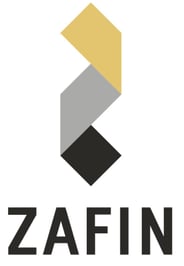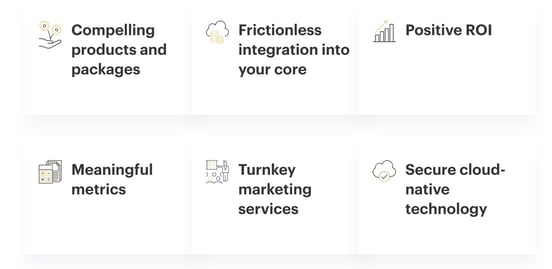

In a Nutshell: Zafin’s Community Advantage solution offers integrated tools that help small banks and credit unions compete with the digital offerings of larger institutions. Community Advantage allows smaller institutions to offer customized perks and incentives, including premium interest rates. Zafin also delivers training and comprehensive internal assessments to ensure that institutions and products are prepared to go to market. Once they launch, a robust feedback loop allows Zafin to support clients and ensure they can provide products and services for their markets.
Big banks typically have far more resources than smaller, local institutions — which offers them a significant advantage. They are often better positioned to research, develop, implement, and manage products that meet consumer needs, and that is especially true in the digital arena. Larger institutions appeal to consumers through their robust online banking portals, mobile apps, and other convenient tools.
Smaller institutions often rely on a grounded attitude and personalized customer service to attract and retain members. However, that competitive edge has dulled during the COVID-19 pandemic as digital access has become necessary because face-to-face service has been discouraged.

“I think the entire market has started to realize it needs to compete more aggressively with the big guys on tech,” said Stephen Clendaniel, Director of Sales at Zafin. “Some of them don’t necessarily think of big banks as their main competitors, but when they look at a particular market and the deposit share in that market, it’s very clear.”
Zafin’s Community Advantage solution provides access to those integrated tools for small financial institutions, including local banks and credit unions. Those institutions leverage Community Advantage to level the playing field and compete more effectively with bigger banks.
“The big guys are in basically every market, even if it’s just from a digital perspective,” Clendaniel said. “We’ve seen a lot of interest ramp up here, especially during COVID-19, but I think that just highlighted a trend that started before. Folks are interested in ramping up their abilities on the digital front.”
Simplifying Core Management Through Externalization
Zafin started in 2005 as a product and pricing platform for Tier-1 banking institutions, which indicates the highest level of financial strength. However, the company’s founding team quickly realized that, despite critical efficiencies, the industry also had substantial inefficiencies.
Corporate banks often had difficulty making changes to core digital banking environments, including managing product definitions across the core components used by institutions brought on by acquisition.
Zafin was designed to externalize certain functions from those cores so that internal business could integrate systems and components more quickly.
“One of our largest banking clients had 40 different cores that they were operating across 50 different countries. That was pretty tough for their internal teams to manage and keep everything straight,” Clendaniel said. “What Zafin did was externalize those things. Especially product definitions, including, ‘What does a checking account look like?’, ‘What are the features, benefits, requirements, and all of the other stuff that goes along with it? And we help them find out what was standardized across all of those different instances.”
Zafin currently works with more than 30 of the world’s largest banks, and it boasts a 100% client retention rate. The company uses the knowledge it gained from those corporations to help smaller institutions compete on a digital level.
“It’s been very successful in that Tier-1 banking space,” Clendaniel said. “And a couple of years ago, we started taking a look at the community banking and credit union space.”
Integrating Solutions for Local Institutions
Zafin recognizes that institutions on the smaller end of the spectrum have different problems with their cores than larger institutions do.
“You’re not going to find many credit unions that are running 40 different instances of a core. However, some of the difficulties are still very similar,” Clendaniel said.
Zafin set about adapting the set of capabilities it developed for Tier-1 banks to solve similar problems experienced by smaller institutions. Local banks and credit unions have offerings, including checking rewards that are often difficult to implement and customize. Community Advantage allows small banks and credit unions to easily define products that will be good fits for their particular markets, and it enables easy implementation, tweaking, and management.

Zafin Community Advantage offers many benefits for small financial institutions and credit unions.
“A lot of institutions can cap debit card transactions, give premium interest rates, or something of that nature. We can take that kind of concept and go beyond it,” Clendaniel said. “For example, one of the institutions we worked with said, ‘It would be great if we could give an enhanced incentive to folks who have been loyal members to the credit union for more than 10 years.’ We can take a look at when that relationship started, and if they meet that threshold, we can give them a premium interest rate or something of that nature.”
Implementing and offering values like those provide an effective way for small institutions to attract customers. And once those customers experience quality products and service, they are more likely to bring their primary financial relationship to a credit union or small bank.
A Platform for Customized Implementation and Onboarding
Zafin’s onboarding process begins with a walkthrough of all relevant details. The company also develops a financial model to assess what product structures will look like for a particular institution based on its rates, fees, and caps, among other details.
“Typically, by the implementation, they’re going to have a pretty good sense of what they’re ready to go to market with,” Clendaniel said. “As we go through that process, we integrate directly into the core. We map out all the different file names and things so the two platforms can talk to each other.”

Stephen Clendaniel, Zafin Director of Sales
The final step is internal training. Zafin personnel teaches the people who will, in turn, train other employees. The company offers that preparation alongside conversations with the employees who manage the institution’s products and retail sides. That holistic approach provides everyone the information they need to ensure products succeed.
Once institutions implement Zafin’s Community Advantage, they find its intuitive graphical user interface internally accessible and fully auditable. Using it requires no sophisticated technological expertise.
“You can see who makes a change, and that’s all tracked for audit purposes, but they can go in and make changes to products without any technical knowledge,” Clendaniel said. “For example, you can go in and say, ‘We want this offer that we’re going to run to go for six months instead of 12 months, and we’re going to be offering 1% instead of .5%.’ That’s all very easy to do with the Zafin platform, even for a non-technical person.”
Zafin: Helping Small Institutions Leverage Innovation
Community Advantage’s ease of use opens the door for small institutions to compete more effectively with tech-oriented and resource-rich big banks. One shining example of its effectiveness is its capacity to implement temporary relief programs. The COVID-19 pandemic inspired that option, but it is applicable to a range of disasters and emergencies.
The solution helps financial institutions easily assist customers in times of need by providing waivers on fees and extending customized credit lines, among other options.
“They could go through the entire membership base, or a particular geographic region, and offer targeted relief,” Clendaniel said. “They can provide services, including fee waivers or other things to modify what they’re charging on deposit accounts.”
Community Advantage provides additional reports and analytics through its dashboard, enabling employees to pull performance report data from the institution’s system. That capability is available for products implemented through Community Advantage and legacy products.
Those features give smaller banks and credit unions more agility to meet customer needs. Zafin offers that same responsiveness through its feedback system and quickly responds to emerging situations.
“As fast as the market is changing right now, from where rates are at to all of the curveballs of COVID-19, being attentive to market feedback is vital,” Clendaniel said. “For example, the time of membership as a qualifying factor — that was something that essentially one of our prospects said, ‘Can you do this?’ And our product team said, ‘That’s a great idea,’ and put it together in a week. We try to have a consistent feedback loop both on the front end of the sale process as well as afterward.”
Advertiser Disclosure
BadCredit.org is a free online resource that offers valuable content and comparison services to users. To keep this resource 100% free for users, we receive advertising compensation from the financial products listed on this page. Along with key review factors, this compensation may impact how and where products appear on the page (including, for example, the order in which they appear). BadCredit.org does not include listings for all financial products.
Our Editorial Review Policy
Our site is committed to publishing independent, accurate content guided by strict editorial guidelines. Before articles and reviews are published on our site, they undergo a thorough review process performed by a team of independent editors and subject-matter experts to ensure the content’s accuracy, timeliness, and impartiality. Our editorial team is separate and independent of our site’s advertisers, and the opinions they express on our site are their own. To read more about our team members and their editorial backgrounds, please visit our site’s About page.




